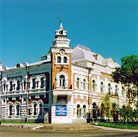 Blagoveshensk is a centre of Amurskaya oblast, 7985 kms eastwards from Moscow. It is situated in southwest of the Zeysko-Bureinskaya plain, on the bank of Amur where the river Zeya flows into it. Blagoveshensk is a centre of Amurskaya oblast, 7985 kms eastwards from Moscow. It is situated in southwest of the Zeysko-Bureinskaya plain, on the bank of Amur where the river Zeya flows into it.
From the very beginning Blagoveshensks has become a really good message about signing of the Aigun treaty of 1858 and returning of Russia to Amur, about the end of the great historical act conceived already by Peter I.
Its place at junction of Zeya and Amur was discovered by Russian trail-blazers of XVII century. In the year of 1856 cossacks and soldiers of the 13th linear battalion - pioneers and first builders - landed here. By the order of the governor-general of Eastern Siberia N.N.Muraviyev they founded a village Ust-Zeyskaya. Soon in July 5 (17), 1858 the village, already renamed Blagoveshchensk, received the status of city.
All its life span Blagoveshensk is closely connected to development of Priamuriye, which business and administrative centre it still remains. By the end of the 19th century it is the largest city on Amur, the capital of gold mining and agriculture of whole Priamursky krai, the major Amur port and centre of Amur navigation.
Since 1948 it is the centre of independent Amurskaya oblast, a part of Russia.
As well as in other Far East cities, many historic and cultural traditions are kept here, and traditions of national culture in particular.
Inhabitants of Blagoveshensk, as well as people of Amurskaya oblast, are very industrious, hardy and hospitable people.
Blagoveshensk always was and still remains one of the largest industrial and cultural centres of the Far East. It is a modern city with industrial enterprises, higher and secondary educational institutions, professional schools, theatres, museums, well-groomed streets and squares, public gardens and parks.
The city population (January 1, 1997) totals 219,9 thousand.
In 4 institutions of higher education and 15 specialized secondary educational institutions study more than 15 thousand students and about 12 thousand pupils correspondingly.
There are the Pedagogical, Medical, Agricultural, Polytechnical Institutes, two Higher Military schools, the oldest in the Far East River School (1899). Besides there are scientific and research institutes: the Amur Complex Institute of the Far East, the All-Russian Institute of Soya, the Far East Zone Veterinary Institute, the Far East Technological Mechanization and Electrification Institute of Agriculture, the Institute of Respiration Physiology and Pathology of the Siberian branch of the Academy of Medical Sciences, etc. The Amur Regional Hydremeteorological Centre is also here.
Blagoveshensk is connected with such outstanding people as writer A.A.Fadeyev, artist A.N.Yar-Kravchenko, scientists V.L.Komarov, M.I.Sumgin. Among founders of the city are governor - general Muraviyev N.N., geologist and paleontologist F.B.Smidt. Blagoveshchensk was visited by P.A.Kropotkin, N.M.Przhevalsky, A.P.Chekhov, etc.
Blagoveshensk is the principle industrial centre of the oblast. Here about a quarter of all its industrial output is made.
The largest enterprises are "Amursky metallist" joint-stock company, producing mine equipment; "Ship-building plant n.a. the October revolution" joint-stock company, making sea towboats and seiners; electro-hardware plant, "Amurenergopribor" producing electrotechnical equipment, and also match factory "Iskra", flour-grinding and creamery factories, big grain elevator, confectionery factory "Zeya", enterprises of building materials.
Being the major transport unit of the oblast Blagoveshensk has a large river port, railway station, airport, bus station. The social infrastructure is highly developed. There are 18 banks and their branches, 7 hotels, more than 100 public catering establishments - restaurants, cafe, dining rooms; 25 drugstores, pharmaceutical stalls, hairdresser's and other establishments including 9 tourist organizations. There are markets - the central and automobile ones, more than 15 small markets.
Nowadays Blagoveshensk is the large trading center of Russia. Through it relations with the countries of Asian and Pacific region are carried out. In the city work about 100 joint ventures and foreign enterprises.
|













 State
State  Cities
Cities